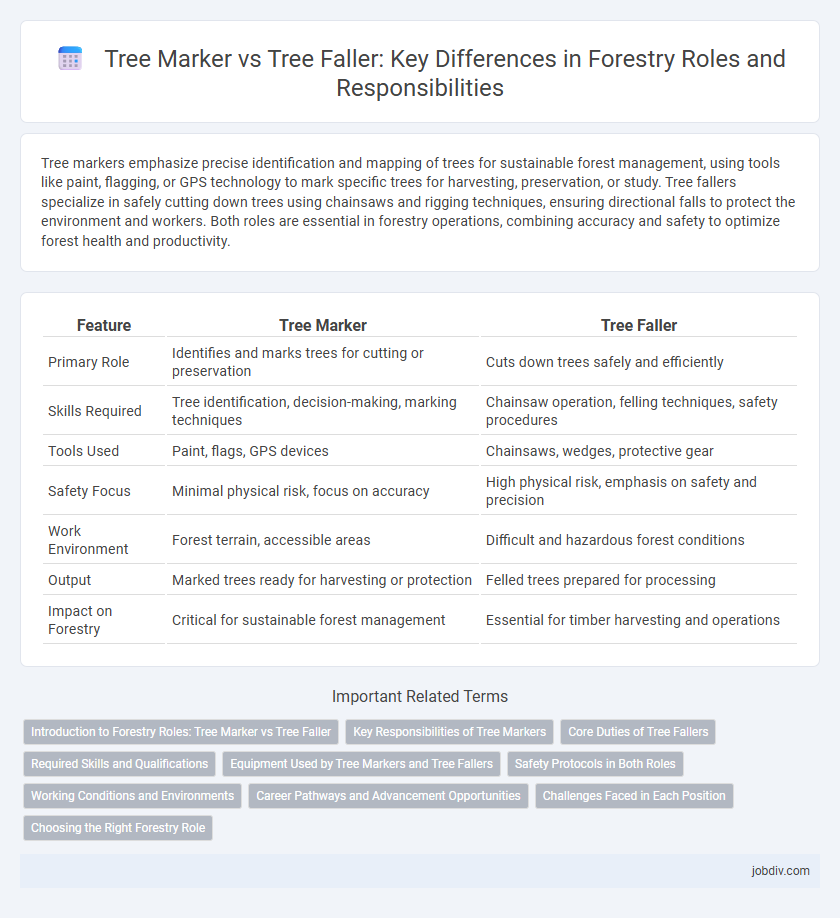Tree markers emphasize precise identification and mapping of trees for sustainable forest management, using tools like paint, flagging, or GPS technology to mark specific trees for harvesting, preservation, or study. Tree fallers specialize in safely cutting down trees using chainsaws and rigging techniques, ensuring directional falls to protect the environment and workers. Both roles are essential in forestry operations, combining accuracy and safety to optimize forest health and productivity.
Table of Comparison
| Feature | Tree Marker | Tree Faller |
|---|---|---|
| Primary Role | Identifies and marks trees for cutting or preservation | Cuts down trees safely and efficiently |
| Skills Required | Tree identification, decision-making, marking techniques | Chainsaw operation, felling techniques, safety procedures |
| Tools Used | Paint, flags, GPS devices | Chainsaws, wedges, protective gear |
| Safety Focus | Minimal physical risk, focus on accuracy | High physical risk, emphasis on safety and precision |
| Work Environment | Forest terrain, accessible areas | Difficult and hazardous forest conditions |
| Output | Marked trees ready for harvesting or protection | Felled trees prepared for processing |
| Impact on Forestry | Critical for sustainable forest management | Essential for timber harvesting and operations |
Introduction to Forestry Roles: Tree Marker vs Tree Faller
Tree markers use specialized tools and GPS technology to identify and designate trees for harvesting, ensuring sustainable forestry practices and optimal resource management. Tree fallers, skilled in chainsaw operation and felling techniques, safely cut down marked trees while minimizing damage to the surrounding environment. Both roles are critical in forest management, combining precision planning with expert execution to maintain forest health and productivity.
Key Responsibilities of Tree Markers
Tree markers play a crucial role in forestry by assessing and selecting trees for harvesting based on species, size, health, and growth patterns to ensure sustainable forest management. They provide precise markings that guide tree fallers in safely and accurately cutting trees, minimizing environmental impact and maintaining forest regeneration. Their responsibilities include conducting stand evaluations, identifying high-value trees, and promoting ecological balance through strategic selection.
Core Duties of Tree Fallers
Tree fallers specialize in safely and efficiently cutting down trees, utilizing chainsaws and expert knowledge of tree structure and environmental conditions to minimize damage. Their core duties include assessing tree lean, determining fall direction, clearing escape paths, and executing precise cuts such as the notch and back cut to control the tree's descent. This role demands physical strength, attention to safety protocols, and situational awareness to protect both personnel and surrounding ecosystems during harvesting operations.
Required Skills and Qualifications
Tree markers require expertise in species identification, tree health assessment, and spatial mapping to accurately designate trees for harvesting or conservation. Proficiency in GPS technology, forestry inventory methods, and knowledge of environmental regulations are essential qualifications. Tree fallers must possess advanced skills in chainsaw operation, tree felling techniques, risk assessment, and physical endurance, supported by certifications in safety training and first aid.
Equipment Used by Tree Markers and Tree Fallers
Tree markers primarily use paint spray guns, flagging tape, and GPS devices to identify and designate trees for harvesting, ensuring precise logging operations. Tree fallers rely on chainsaws, felling wedges, and protective gear such as helmets and chaps to safely cut and bring down selected trees. Both professions depend on specialized equipment tailored to their distinct roles within sustainable forest management and timber harvesting processes.
Safety Protocols in Both Roles
Tree markers and tree fallers adhere to distinct safety protocols tailored to their roles in forestry operations. Tree markers prioritize site assessment, identifying hazardous trees and marking them with visible tags or paint for clear communication, minimizing risks for subsequent operations. Tree fallers implement strict PPE requirements, precise cutting techniques, and escape path planning to control tree direction and ensure personal safety during felling.
Working Conditions and Environments
Tree markers operate primarily in varied forest terrains, assessing and marking trees for harvesting based on species, health, and market value, often working under changing weather conditions and requiring precise navigation skills. Tree fallers work in more physically demanding and hazardous environments, responsible for safely cutting and directing the fall of trees, typically using chainsaws and protective gear in dense forest areas with potential risks like falling debris and unstable ground. Both roles require specialized knowledge of forestry safety protocols, but tree fallers face higher immediate physical risks due to their direct involvement in tree felling operations.
Career Pathways and Advancement Opportunities
Tree markers specialize in assessing and marking trees for harvest, requiring knowledge in forestry, mapping, and environmental regulations, which opens pathways toward roles in forest management and environmental consulting. Tree fallers perform the physically demanding task of safely cutting down trees, developing advanced skills in chainsaw operation and safety protocols, often progressing to supervisory positions or specialized logging operations. Career advancement for tree markers frequently involves further education in forestry or natural resource management, while tree fallers may advance through certifications and experience to roles like lead faller or safety trainer.
Challenges Faced in Each Position
Tree markers face challenges such as accurately identifying and marking trees for harvest while considering ecological impact and regeneration plans. Tree fallers confront physical dangers including handling heavy equipment, precise cutting to avoid accidents, and navigating uneven terrain. Both roles demand high levels of skill and safety awareness to ensure sustainable and safe forestry operations.
Choosing the Right Forestry Role
Choosing between a Tree Marker and a Tree Faller depends on skill set and safety considerations; Tree Markers use specialized knowledge to identify and tag trees for harvest, ensuring sustainable forest management, while Tree Fallers perform the precise and hazardous task of cutting down trees using chainsaws and other equipment. Understanding the physical demands, safety protocols, and technical expertise required for each role is crucial for efficient forestry operations. Proper role allocation improves productivity, minimizes accidents, and supports environmental conservation efforts.
Tree Marker vs Tree Faller Infographic

 jobdiv.com
jobdiv.com